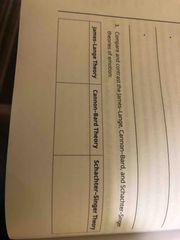![]()
![]()
![]()
Use LEFT and RIGHT arrow keys to navigate between flashcards;
Use UP and DOWN arrow keys to flip the card;
H to show hint;
A reads text to speech;
24 Cards in this Set
- Front
- Back

Front (Term) |

Back (Definition) |
|
|
It is involved with attention and fear, helps interpret facial expressions, and is part of the intrinsic memory system for emotional memory. |
Amygdala |
|
|
Sensory processing station |
Thalamus |
|
|
Releases neurotransmitters that affect mood and arousal |
Hypothalamus |
|
|
Creates long term explicit or episodic memories |
Hippocampus |
|
|
It is involved with planning, expressing personality, and making decisions. |
Prefrontal Cortex |
|
|
List the parts that are involved in the limbic system processsing for emotions. |
Hypothalamus, amygdala, thalamus, hippocampus Prefrontal Cortex |
|
|
It is critical for contilling emotion responses from the amygdala and decision making |
Ventromedial prefrontal cortex |
|
|
Which hemisphere is likely activated when recoginizing facial expressions? |
Non-dominant hemisphere usually the right one |
|
|
Which hemisphere is likely will have a more activity when experiencing positive emotions? |
Left hemisphere |
|
|
List all the universal emotions |
Happiness, sadness, contempt, surprise, fear, disgust and anger |
|
|
Difference between fear and surprise |
Fear - lips pulled toward the ears Surprise - curved jaws open |
|
|
This involves of subjective evaluation first of the stimulus whether it will evoke positive or negative emotions |
Lazarus Theory |
|
|
Nervous system arousal and interpretation of context lead to a cognitive response |
Schachter-Singer Theory |
|
|
Simultaneous arousal of the nervous system abd cognitive response lead to an action. |
Cannon-Bard Theory |
|
|
Nervous system arousal leads to a cognitive reaponse in which the emotion is labeled |
James-Lange Theory |
|
|
What are the three components of emotion? |
Cognitive, behavioral and physiological |
|
|
It is a state of mind or feeling that is subjectively experienced based on circumstances, mood and relationships. |
Emotion |
|
|
What part of the of the Hippocampus controls the explicit memory system? |
Medial temporal lobe |
|
|
The consciousness memory of the emotional event |
Explicit memory |
|
|
Expression of the actual feelings stored |
Implicit memory |
|
|
T or F. Females tend to have more activity in the dominant hemisphere which is the right hemisphere than males do. |
F. Non-dominant hemisphere |
|
|
Dictates emotional states |
Hypothalamus |
|
|
Difference between dorsal prefrontal cortex and ventral prefrontal cortex. |
First one is for attention and cognition and the later one is for experiencing conscious emotions. |

